If you’re new to Backgammon, check out our exclusive tutorial to learn the official Backgammon rules. Our step-by-step guide will walk you through the basics of backgammon, including setting up the board, using the doubling cube, and playing according to proper etiquette, as observed at the prestigious Monte Carlo world championship.
Equipment
To play backgammon, you need the following equipment:
- Backgammon Board, Table or Backgammon Table Top
- 2 x 30 checkers (15 checkers per player)
- 2 x pairs of (precision) dice
- Two dice cups
- Doubling Cube
Optional Backgammon Equipment
- Backgammon / Chess Clock
- Scoreboard
- Backgammon Chips (when you play for real money)
The Board
The board is divided into two halves with a bar in the middle. The two halves are then divided into four boxes with six triangular points in each box, with 24 points (or pips) in total.
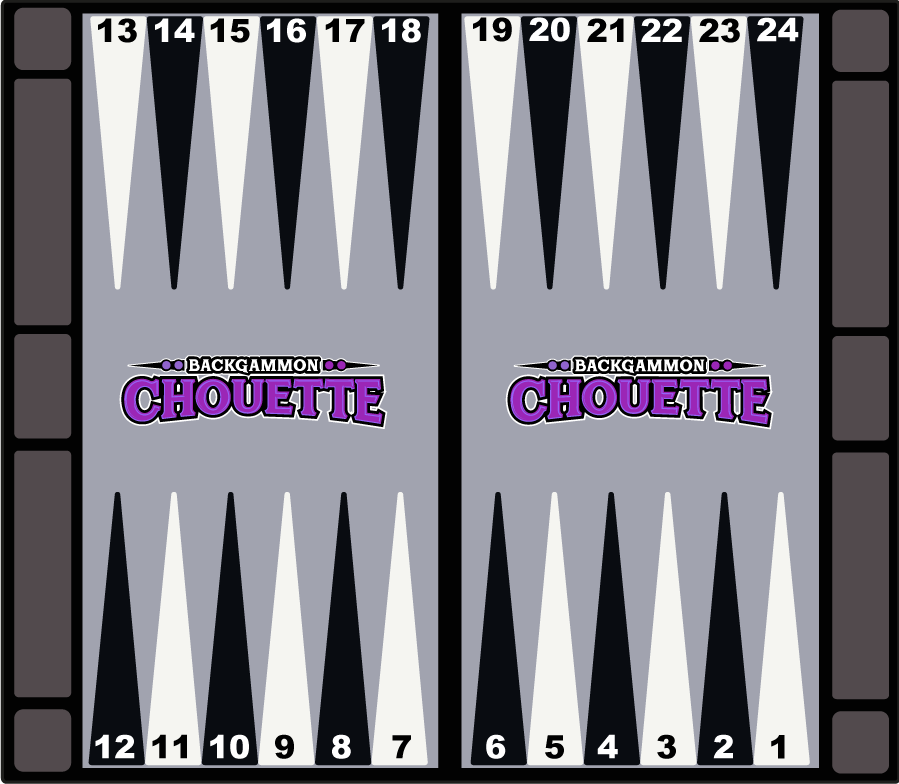
The four boxes or halves of the board are defined as
- Your home Board (Red)
- Your away Board (Red)
- Your opponent’s away Board (Purple)
- Your opponent’s home Board (Purple)
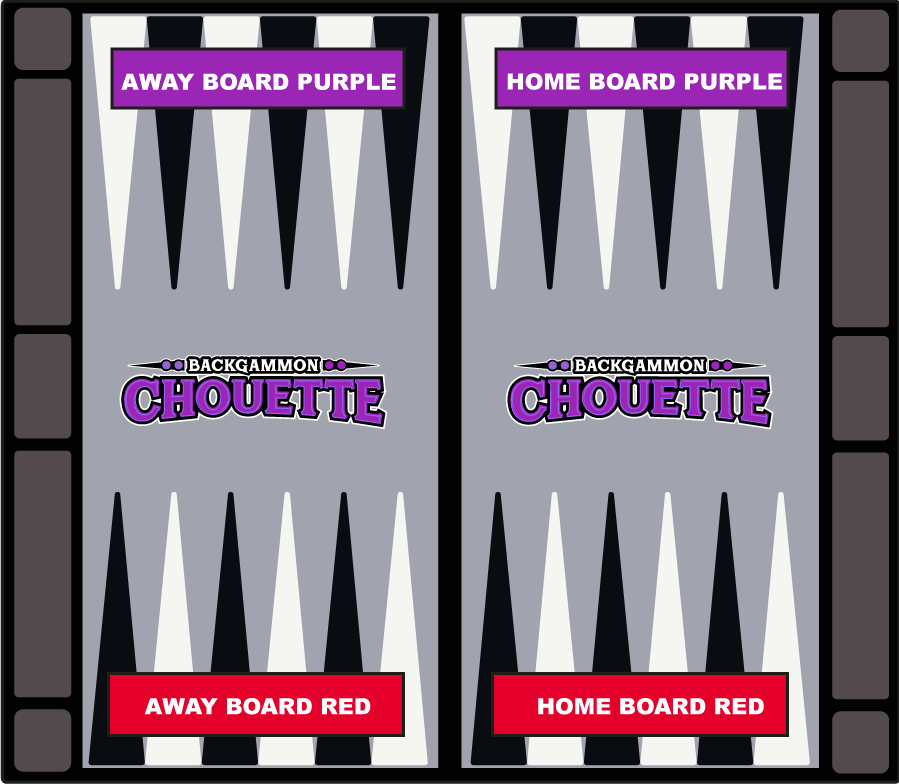
The Object of the Game
The game’s object is to be the first player to move all fifteen of their checkers around the board and bear them off. Before you can bear your checkers off, you must move all fifteen checkers into your home board.

Once you have all your checkers in your home board, you can start to take all your checkers out. The first player who has taken all his checkers out of the game will win.

Here you can see that Red moved all his checkers to his home board. He is now ready to take all his checkers out.
Start of the Game
Before we start the game, we have to place the checkers in the right spots according to the backgammon setup. Each new game will have this same setup.
Backgammon Setup
Both players will have the same setup. The picture below shows the starting setup where player red is playing against player purple.
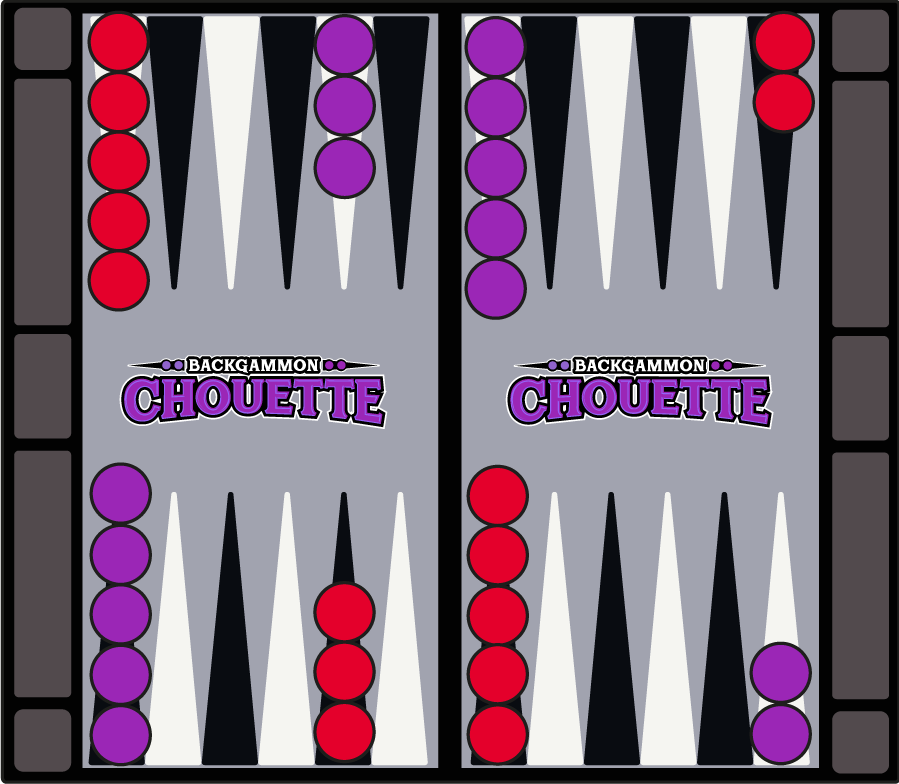
If you always forget how to set up backgammon? Read our page about backgammon setup, where you can read some easy tricks and never to forget how to set up a backgammon game.
How to determine who will start the game?
To start a backgammon game, each player must first roll one die. This is to determine which player starts first and what the numbers of the opening roll will be. By identical rolls, both players roll again until both players have different results. The player with the higher number rolled will now move his checkers according to the numbers revealed by both dice. After his turn ends, the other player rolls two dice to determine his first move.
How to move your checkers
The outcome of the dice roll determines how many pips a player will move their checkers. It is important to note that checkers can only be moved forward – not backward.
Rules regarding the movement of the checkers
- When playing checkers, players must move their pieces to an available spot on the board—a space not already occupied by two or more of their opponent’s checkers.
- The number that turns up for each die rolled is used individually to move a checker.
For example, if a player rolls 2 and 6, he may move one checker two pips to an open point and another six pips to an open point, or he may move one checker eight pips instead. However, when you play eight pips with one checker, there must be an open space to land in between either on the two or the 6-point away from the start point of the checker.

Example Opening Roll: 2 and 6 with two checkers or 8 with one checker
- When a player rolls a double, which means both dice show the same number, they are rewarded with twice playing the numbers shown on the dice. For example, By rolling a three and a three, the player has four threes to use.
- A player must always use both numbers on any dice roll if legally possible. (or all four numbers in case of doubles).
- Whenever it’s legally possible to play both numbers, you have to play them.
- If only one number can play, you have to play that number.
- You must play the largest number if only one of two numbers can be played.
- The player’s turn is over when neither of the numbers rolled can be used.
- The player must play as many numbers as possible when rolling a double.
Landing on a Point
On each turn, the player rolls two dice and has to move the checker according to the outcome of the dice roll. He always has to land his checkers on two points, even when he decides to move one checker.
A checker can land on any point that is
- Open (empty)
- Occupied with one or more checkers of the same player (there is no maximum so that you can place 15 checkers on one single point)
- Any point occupied by only one checker of the opponent’s player.
You can’t land a checker on any point occupied by two or more checkers of your opponent. When your opponent has two or more checkers on a point, that point is blocked for you to land on.
Hitting your Opponent
- A point occupied by a single checker is called a blot; when you land your checker on your opponent’s blot, you “hit” your opponent’s checker, which now will be placed on the bar.
- When a player has one (or more) checkers on the bar, he must first reenter these checkers before he can move any other checker on the board.
- Checkers must reenter in your opponent’s home board, the farthest away from your home board.
- A checker can only reenter the opponent’s home board when that point is eligible to land, meaning an open point or a blot corresponding with one of the numbers on the rolled dice.
- He loses his turn if the player can’t land his checker when reentering.
- If the player is hit and has more checkers on the bar, he must enter as many checkers as possible before ending his turn.
- After all your checkers are reentered in your opponent’s home board, You can move your other checkers around the board again.
The End Game – Bearing off
When you have moved all your checkers into your home board, you are eligible to take your checkers off the board. This we call bearing off, and there are certain rules applied to this process:
- When you roll a number, you can either remove a checker placed on the corresponding point or move the checker forward.
- When you roll a Double (both dice show the same number), you can take four checkers off, play them forward, or combine them.
- When there are no longer checkers on a higher point whose number is rolled, you must take a checker out from the highest point occupied.
Let’s say you roll a six, but you only have checkers on your one, two, and three-point; then you bear off a checker from your three-point.
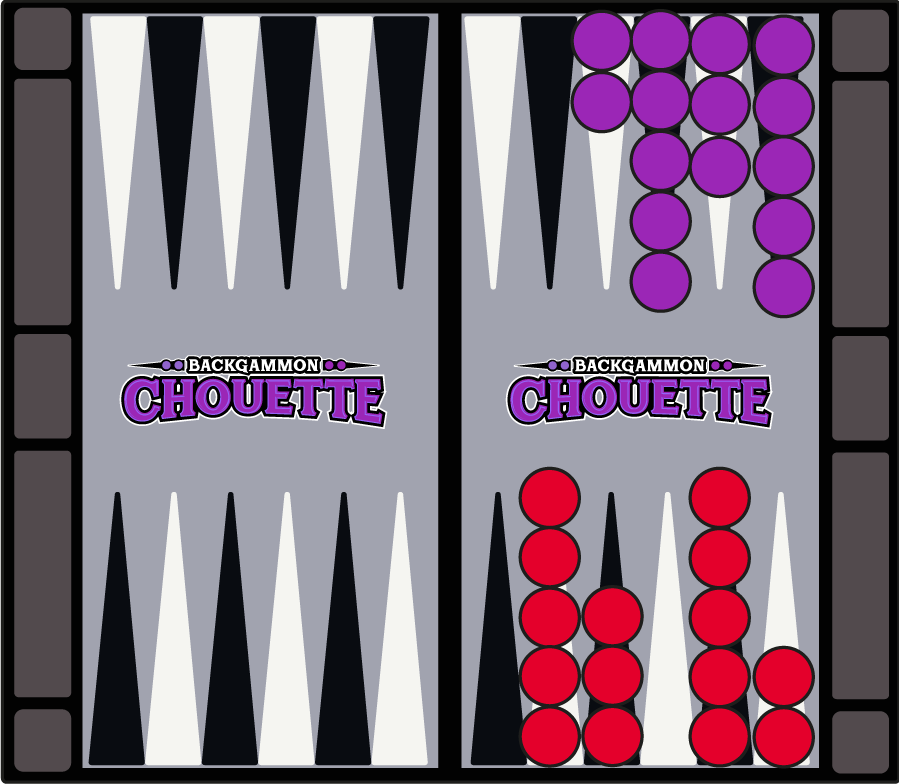
In the picture above, red and purple are both ready to “bear off” their checkers.
Scoring, Betting, and Payout
You win the game by taking out all your checkers before your opponent.
There are three options for how you can win the game and which affects the scoring:
- “Single Game” or “Single Point”
- “Gammon”
- “Backgammon”
Standard “Single” Win (1 point)
When you win, but your opponent already took at least one checker out, you win with a single point (x1)
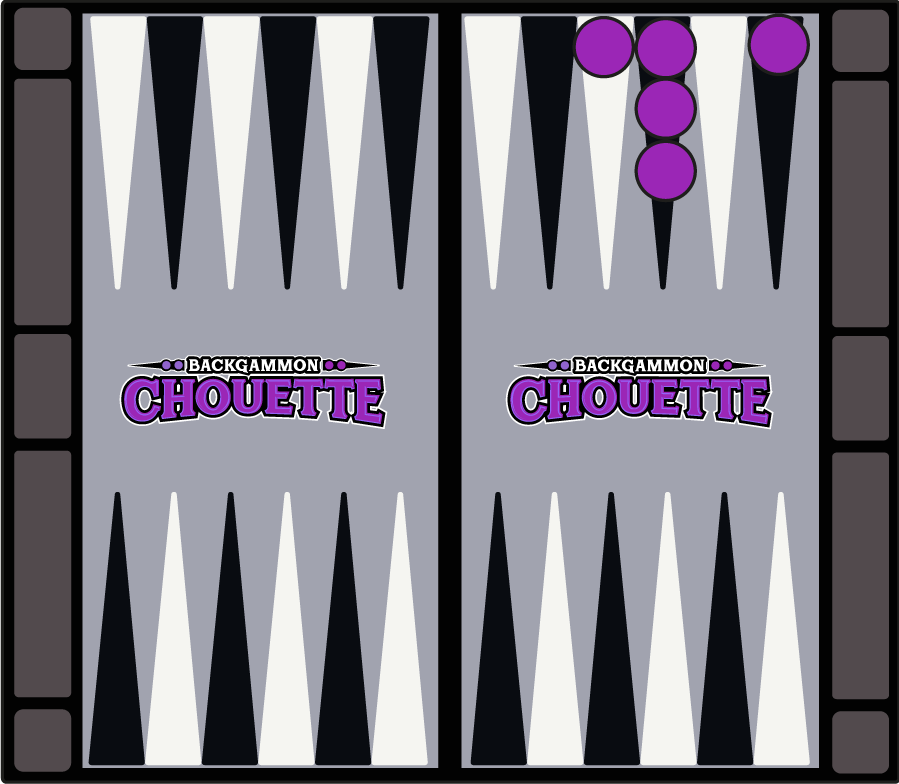
Red took all his checkers out and on the match since Purple still needs to “bear off” 5 of his checkers. Because Purple managed to already took at least 1 checker out he only losses a single game (x1)
Gammon (2x)
When you win, and your opponent didn’t take a single checker out yet, regardless of whether or not he has placed all his checkers in his home board, you win with a Gammon, which means you win 2 points (x2)
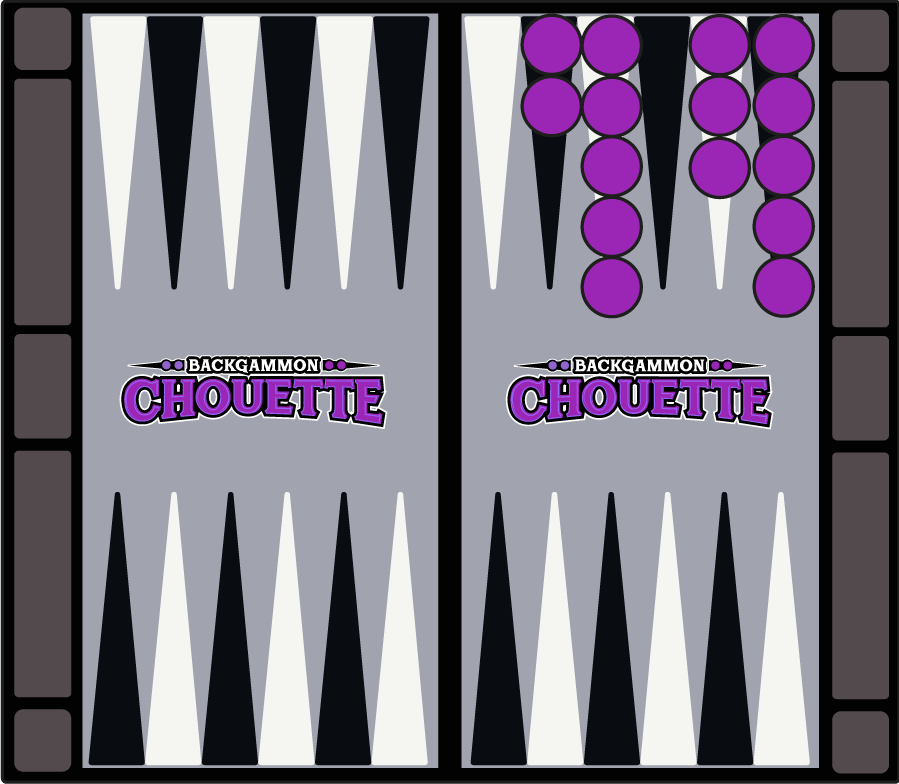
Backgammon (3x)
When you win, and your opponent didn’t take a single checker out, AND he still has checkers in your home board or at the bar, you win with a Backgammon. This means you win 3 points.
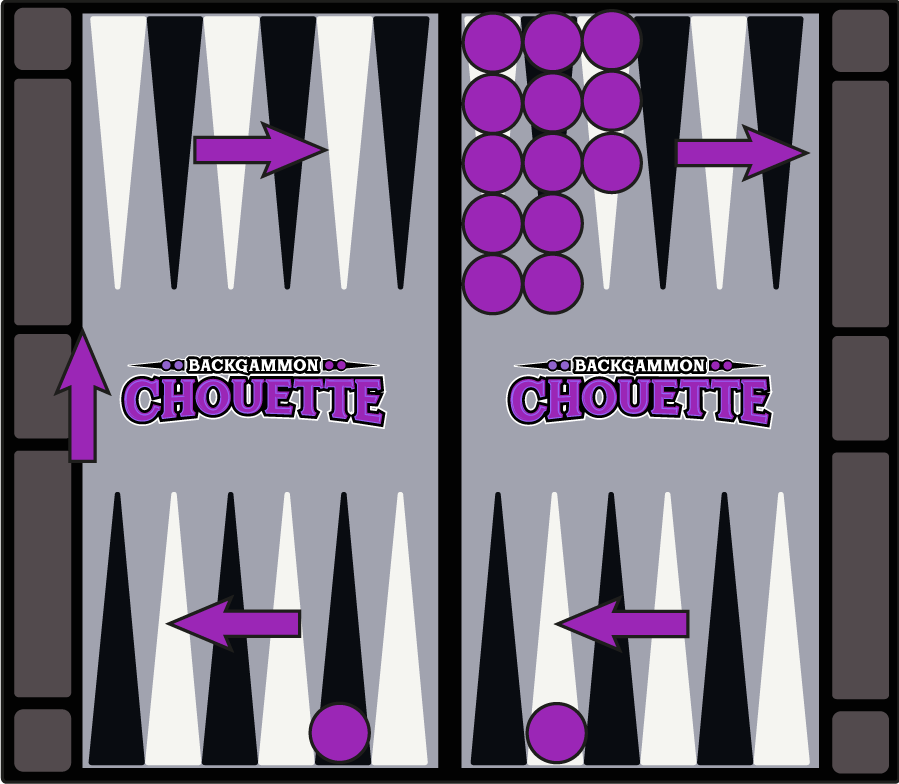
Red took out all his checkers. Because purple still has one checker in Red’s home board, Red wins with a “Backgammon” (x3)
When playing backgammon for real money, you choose a particular stake which will be set as the initial bet per point. This initial bet will be multiplied by 2 or 3 if a game is won with a “Gammon” or “Backgammon.”
Backgammon Etiquette
Players are expected to follow a code of etiquette in Backgammon to maintain fairness and sportsmanship during the game. Here are some commonly accepted practices in backgammon etiquette:
Rules and Etiquette regarding Dice Rolling in Backgammon
- A player can only roll the dice in his right half of the board. His opponent can only roll in the other half of the board.
- Dice cups are mandatory and must be shaken properly before rolling the dice.
- A roll is only valid when the dice are rolled several times over the surface of the playing field.
- A roll is only valid when both dice are landed flat on the surface.
- A die landed flat on top of a checker is generally invalid, although there is a discussion about changing this rule to make these rolls also valid.
- You are only allowed to roll when your opponent has picked up both his dice at the end of his turn or when your opponent hits the clock. If you roll your dice before, your opponent can declare the roll invalid.
Etiquette regarding Checkerplay
- When it’s not your turn, you are not allowed to touch any of the checkers on the board, also not your own checkers.
Doubling and the use of the Doubling Cube
- The Doubling cube, often called “Cube,” is a 6-sided dice with the numbers 2, 4, 8, 16, 32, and 64.
- At the start of each new game, the cube is placed in the middle with the 64 turned upwards. This means that the Cube is not in use yet.
- At this point, the game can be won by either one (single game), two (gammon), or three (backgammon) points (or times the initial bet)
- Any of the two players who think to have an advantage over his opponent can choose to double at the beginning of his turn before he rolls his dice.
- The player who doubles announces that he doubles and takes the Doubling Cube and turns it in a way that the number 2 is on top to hand it over to his opponent.
- The opponent can now choose to accept the double or refuse the double.
- The other player wins with a single point, and the game ends if the opponent refuses the double.
- If the player accepts the double, he “takes” the cube and keeps it on his side of the board, with the two on top.
- At this point, the initial stake is doubled, which means the game can now be won by either two (single game), four (gammon), or six (backgammon) points (or times the initial bet)
- By accepting the Double, this player now becomes the proprietor of the cube and thus has exclusive eligibility to redouble optionally.
- When he wants to redouble, he takes the dice, turns it over so that the four will be visible on top, and places the Cube in the middle.
- Now the opponent has to decide to either accept or refuse. If the redouble is taken, the original stakes are multiplied four times; Gammons is worth 8 points, backgammons are worth 12 points, or when played for money, 12 times your initial bet.
Match Game or Single Game
Often backgammon is played in a series of games; therefore, backgammon can be played in MATCH format or SINGLE CASH GAME format.
Match Game Format
You play to an odd number of total points (3, 5, 7, etc.)
The first player who reaches the set number of points will win the match.
Regarding using the Cube, an important rule is only applied when playing a Match game format: the Crawford Rule.
Crawford Rule
- When one of the players reaches the matchpoint, the Cube cannot be used in the following game. For example: If you play a match to 5 points, when a player reaches a score of 4, the cube will not be used for the next game.
- In case the player who reaches the matchpoint loses that game, then the Cube can be used again in the game after.

Single Cash Game format
- When playing backgammon, according to the cash game principle, you play a (un) a limited number of games in a row.
- You choose an initial stake that can be multiplied by gammons, backgammons, or the doubling cube during the games.
- Players can set a particular number of games they want to play on the forehand or choose to play until someone is broke or gives up.
When playing cash games, some additional rules should be set before the beginning of the first series of games. These rules are:
Automatic Doubles
- When both players roll the same number while rolling for their first turn, this triggers a doubling of stakes. The doubling cube is then rotated to 2 and placed back in the center.
- Automatic doubles can be played limited or unlimited, so every time the exact number rolled in a row will turn the Cube and multiply the stakes accordingly.
Beavers
- When a player is doubled, he may immediately redouble (referred to as “beaver”) while maintaining the owner of the cube. The initial doubler can accept or decline this offer like any other double.
Jacoby Rule
- The Jacoby rule is invented to speed up the game but must be considered an additional, not standard, rule. The rule consists that to score a Gammon (x2) or Backgammon (x3), at least one of the two players must have doubled the stakes.

